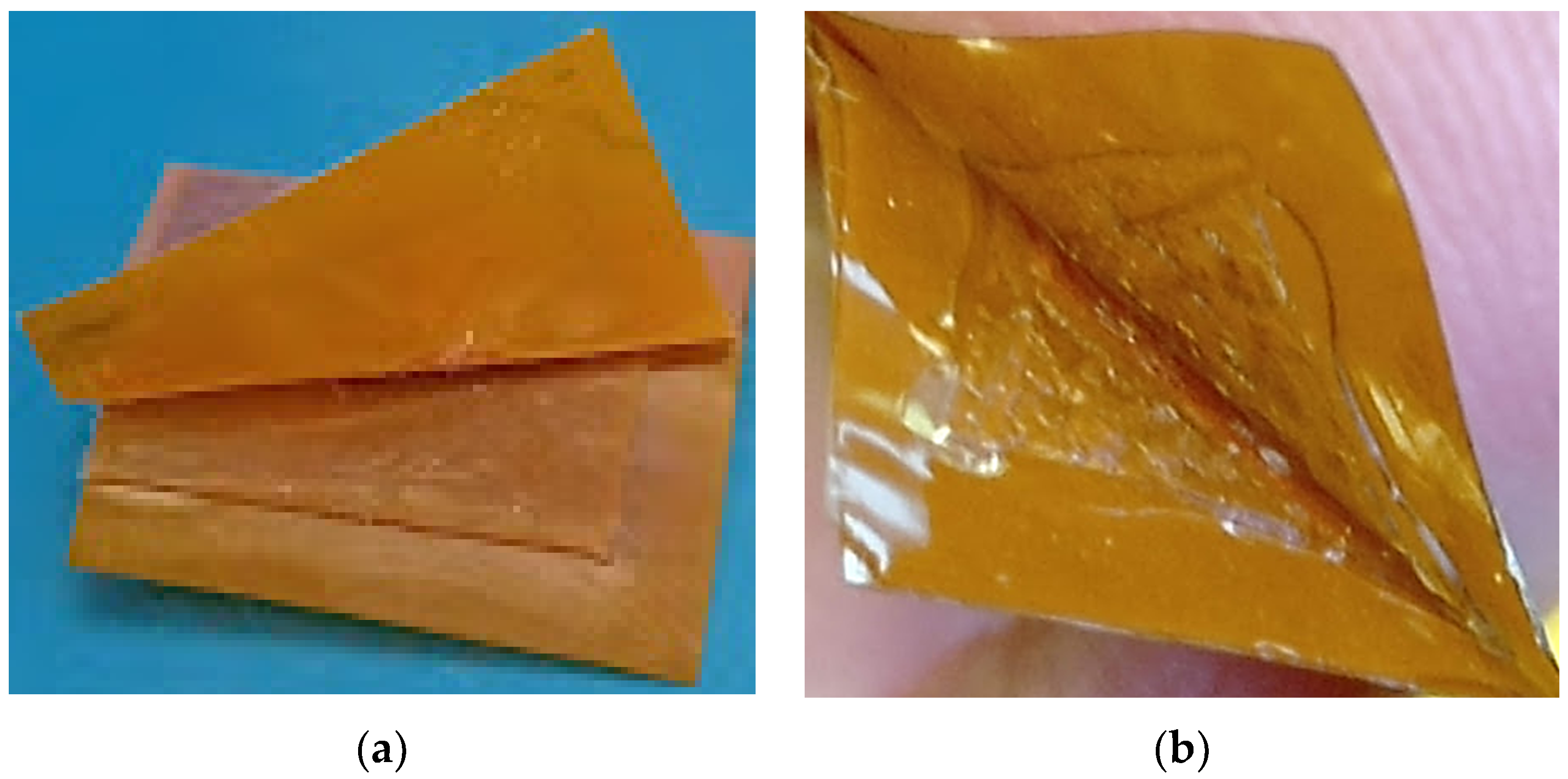An Optimized Methodology to Achieve Irreversible Bonding between PDMS and Polyimides for Biomedical Sensors †
Abstract
1. Introduction
2. Materials and Methods
2.1. Sensor Designing
2.2. Sensor Fabrication
2.2.1. Sensor Pattern Development
2.2.2. Plasma Treatment of PDMS and Polyimide
2.2.3. Chemical Solution Preparation and Surface Functionalization
2.2.4. Final Assembling of Sensor
3. Results and Discussion
4. Conclusions
Author Contributions
Funding
Conflicts of Interest
References
- Khaleel, H.R.; Al-Rizzo, H.M.; Rucker, D.G.; Mohan, S. A compact polyimide-based UWB antenna for flexible electronics. IEEE Antennas Wirel. Propag. Lett. 2012, 11, 564–567. [Google Scholar] [CrossRef]
- Richardson, R.R., Jr.; Miller, J.A.; Reichert, W.M. Polyimides as biomaterials: Preliminary biocompatibility testing. Biomaterials 1993, 14, 627–635. [Google Scholar] [CrossRef] [PubMed]
- Farooq, M.; Iqbal, T.; Vazquez, P.; Farid, N.; Thampi, S.; Wijns, W.; Shahzad, A. Thin-film flexible wireless pressure sensor for continuous pressure monitoring in medical applications. Sensors 2020, 20, 6653. [Google Scholar] [CrossRef] [PubMed]
- Moon, J.-H.; Baek, D.H.; Choi, Y.Y.; Lee, K.H.; Kim, H.C.; Lee, S.-H. Wearable polyimide--PDMS electrodes for intrabody communication. J. Micromech. Microeng. 2010, 20, 25032. [Google Scholar] [CrossRef]
- Hoang, M.V.; Chung, H.-J.; Elias, A.L. Irreversible bonding of polyimide and polydimethylsiloxane (PDMS) based on a thiol-epoxy click reaction. J. Micromech. Microeng. 2016, 26, 105019. [Google Scholar] [CrossRef]
- Agostini, M.; Greco, G.; Cecchini, M. Polydimethylsiloxane (PDMS) irreversible bonding to untreated plastics and metals for microfluidics applications. APL Mater. 2019, 7, 81108. [Google Scholar] [CrossRef]
- Kim, D.H.; Song, J.; Choi, W.M.; Kim, H.S.; Kim, R.H.; Liu, Z.; Huang, Y.Y.; Hwang, K.C.; Zhang, Y.W.; Rogers, J.A. Materials and noncoplanar mesh designs for integrated circuits with linear elastic responses to extreme mechanical deformations. Proc. Natl. Acad. Sci. USA 2008, 105, 18675–18680. [Google Scholar] [CrossRef]


Publisher’s Note: MDPI stays neutral with regard to jurisdictional claims in published maps and institutional affiliations. |
© 2022 by the authors. Licensee MDPI, Basel, Switzerland. This article is an open access article distributed under the terms and conditions of the Creative Commons Attribution (CC BY) license (https://creativecommons.org/licenses/by/4.0/).
Share and Cite
Farooq, M.; Amin, B.; Elahi, A.; Wijns, W.; Shahzad, A. An Optimized Methodology to Achieve Irreversible Bonding between PDMS and Polyimides for Biomedical Sensors. Eng. Proc. 2022, 27, 14. https://doi.org/10.3390/ecsa-9-13223
Farooq M, Amin B, Elahi A, Wijns W, Shahzad A. An Optimized Methodology to Achieve Irreversible Bonding between PDMS and Polyimides for Biomedical Sensors. Engineering Proceedings. 2022; 27(1):14. https://doi.org/10.3390/ecsa-9-13223
Chicago/Turabian StyleFarooq, Muhammad, Bilal Amin, Adnan Elahi, William Wijns, and Atif Shahzad. 2022. "An Optimized Methodology to Achieve Irreversible Bonding between PDMS and Polyimides for Biomedical Sensors" Engineering Proceedings 27, no. 1: 14. https://doi.org/10.3390/ecsa-9-13223
APA StyleFarooq, M., Amin, B., Elahi, A., Wijns, W., & Shahzad, A. (2022). An Optimized Methodology to Achieve Irreversible Bonding between PDMS and Polyimides for Biomedical Sensors. Engineering Proceedings, 27(1), 14. https://doi.org/10.3390/ecsa-9-13223






